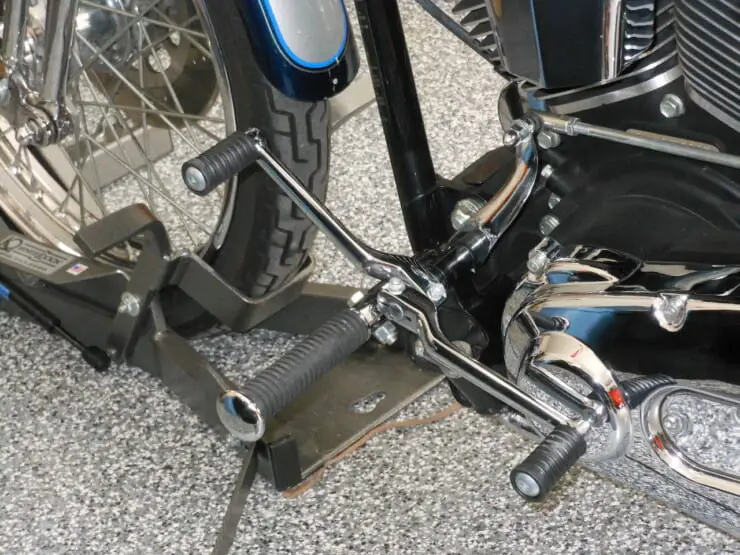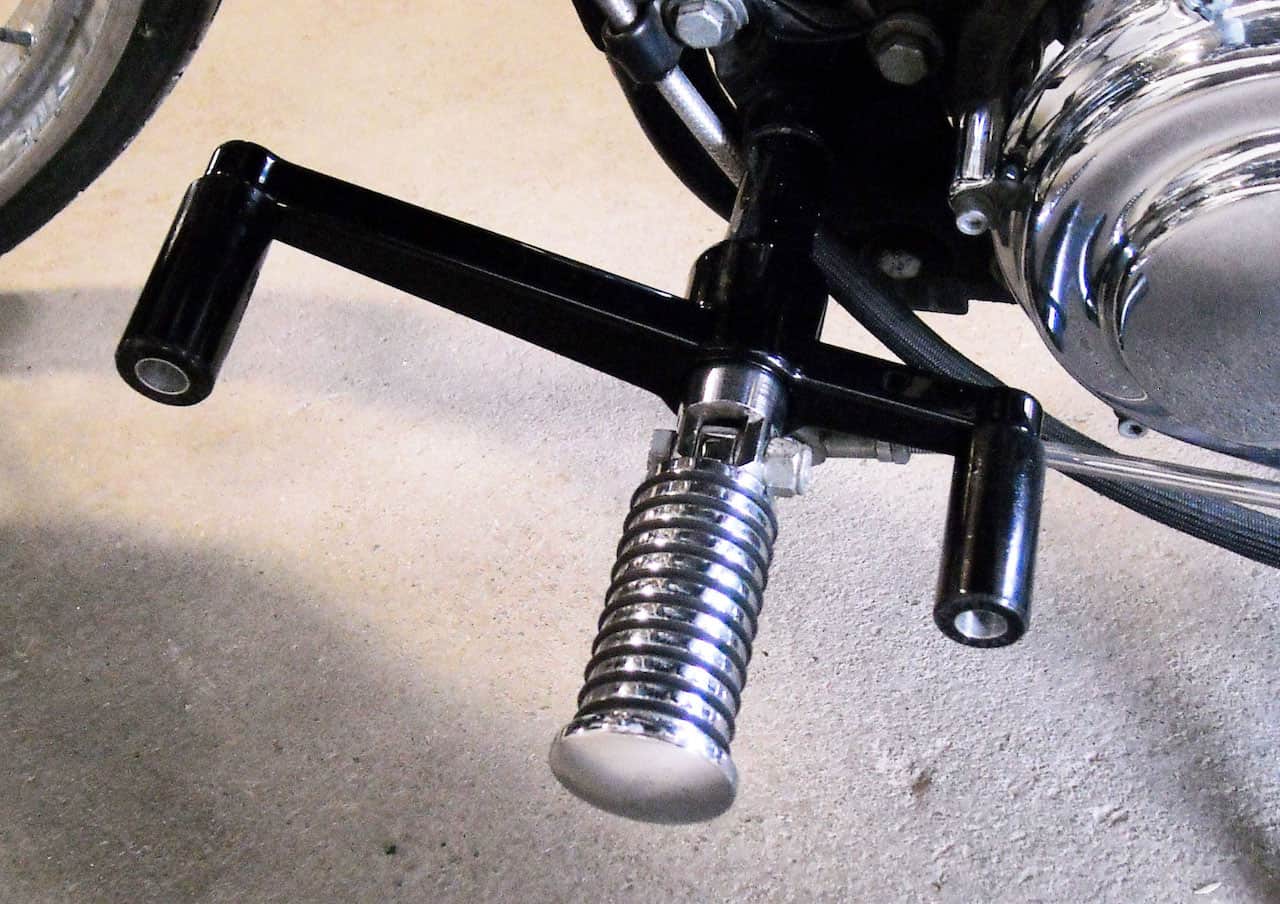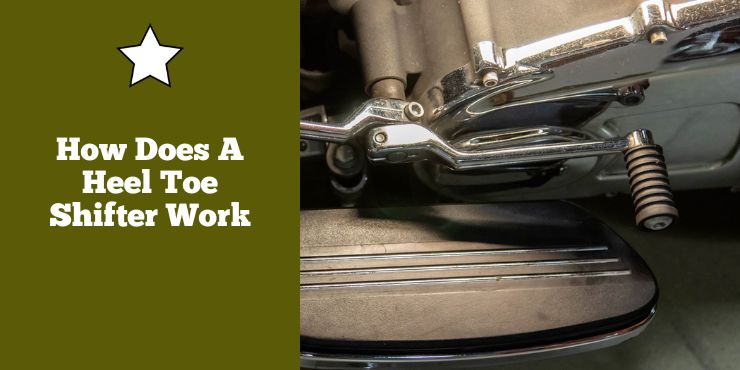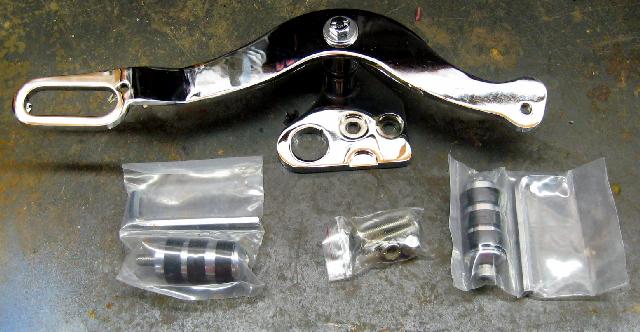Welcome to our comprehensive guide on understanding how a heel toe shifter works and mastering gear shifting on motorcycles. If you’ve ever been curious about the mechanics behind this unique gear-shifting technique, you’ve come to the right place.
A heel-toe shifter allows the rider to upshift by pressing with the heel and downshift with the toe, enabling quick gear changes without lifting the foot off the peg.
In this article, we’ll break down the functionality of a heel toe shifter, explore its benefits, and provide step-by-step instructions to help you become proficient in its usage. Whether you’re a seasoned rider or a beginner looking to expand your skills, read on to discover everything you need to know about the fascinating world of heel toe shifting.
What is a Heel Toe Shifter?
Harley-Davidson is one of the most iconic brands as these motorcycles are known for their classic design, powerful engine, and other unique features. One of the handiest features of a Harley is the heel-toe shifter, which allows the bikers to shift gears with their heel or toe.
The heel-toe shifter on a Harley-Davidson bike is a type of gear shifter that allows the bikers to shift gears using either their heel or toe. This feature is designed to make shifting gears much easier and more comfortable for bikers, especially during long rides. The heel-toe shifter is located on the left side of the bike and is connected to the transmission.

The Harley-Davidson heel-toe shifter is a unique feature that offers various benefits to riders. First, it’ll allow the riders to shift gears more easily and with minimal effort. Instead of needing to lift their entire foot off the footpeg for shifting gears, riders can just tap the shifter with their heel or toe. This can be quite helpful for bikers with large boots or those people who have difficulty reaching the shifter with their toes.
Another important benefit of the heel-toe shifter is that it’ll allow the riders to shift gears quickly and smoothly. By using their heel or toe for shifting gears, riders will be able to maintain better control of the bike and avoid jerky or abrupt shifts. This can help in reducing wear and tear on the transmission and improve the overall performance of your bike.
It is also designed to be more comfortable for bikers. By allowing them to easily shift gears with their heel or toe, the shifter will reduce the strain on their legs and feet, which can be beneficial during long rides. Moreover, the shifter is often adjustable, which allows the riders to customize it to their specific needs and preferences.
Parts and components of the heel-toe shifter on Harley-Davidson bikes
Heel-toe shifters provide riders with increased comfort and control when shifting gears. Understanding the different parts and components of the heel-toe shifter will be important for properly maintaining and repairing it. Here are the different parts and components of heel-toe shifters –
#1. Heel-toe lever
The heel-toe lever is the main component of the heel-toe shifters. It is a large, pivoting lever located on the left side of the bike, near the footpeg. The heel-toe lever comprises two parts, the heel shifter, and the toe shifter, which are connected by a pivot point. This pivot will allow the rider to shift gears using either their heel or toe.
#2. Toe shifter
The toe shifter is the portion of the heel-toe lever used for shifting gears with the rider’s toe. It’s located at the front of the lever and is comparatively smaller than the heel shifter. The toe shifter will be connected to the transmission through a linkage assembly.
#3. Heel shifter
The heel shifter will be the portion of the heel-toe lever used for shifting gears with the rider’s heel. It is located at the back of the lever and is much larger than the toe shifter. The heel shifter will also be connected to the transmission through a linkage assembly.
#4. Linkage assembly
The linkage assembly is essentially a series of rods and connections that connect the heel-toe lever to the transmission. The linkage assembly is responsible for transmitting the rider’s shift input to the transmission. It is typically adjustable, which allows the riders to customize the shifter’s position and travel to suit their riding style and preferences.
#5. Shifter shaft
The Shifter shaft is the component that connects the transmission to the heel-toe lever. It is a long, slender shaft that is typically located on the left side of the motorcycle. The shifter shaft is responsible for transmitting the biker’s shift input from the heel-toe lever to the transmission.
#6. Shift pawl
The shift pawl is a component located inside the transmission. It is responsible for engaging and disengaging the transmission gears as the rider shifts. The shift pawl is operated by the linkage assembly and the shifter shaft.
How does a heel-toe shifter work?
Using a heel-toe shifter is a unique and comfortable way of shifting gears on your Harley-Davidson bike. Whether you’re a seasoned biker or simply starting out, it is important to know how does a heel-toe shifter work if you want to make the most out of your riding experience.
Step 1: Preparing to use the shifter
Before using the Harley-Davidson heel-toe shifter, it will be important to properly position your feet on the footpegs. Your feet need to be securely positioned with the ball of your foot resting on the footpeg and the heel resting on the heel shifter. This will allow you to easily use your toe for tapping the toe shifter and your heel to tap the heel shifter.
Step 2: Moving the shifter
For shifting up, you should just tap the toe shifter with the ball of your foot. This will engage the next higher gear in the transmission. As you’re tapping the toe shifter, you must apply a small amount of pressure on the shifter to make sure you’re getting a smooth transition. As the transmission engages the new gear, you’ll be able to release the clutch lever and accelerate.
For shifting down, you should tap the heel toe shifter with your heel. This will engage the next lower gear in the transmission. Just like shifting up, you will also need to apply a small amount of pressure on the shifter for ensuring a smooth transition. As the transmission engages the new gear, you will be able to release the clutch lever and decelerate.
The shifter moves freely, easily, and smoothly with minimal effort. If you find that the shifter is difficult to move or is sticking, it might be necessary to adjust the shifter position or linkage assembly.
Step 3: Finishing the shifting process
After shifting gears, it’ll be important to make sure that the transmission is properly engaged before you release the clutch lever. This can be easily done by feeling of the engage to engage with the new gear and verifying that the bike isn’t lurching or stalling. It is also important that you be aware of your bike’s speed and gear selection, especially when approaching turns or changing road conditions. You should be aware of the surroundings and use the heel-toe shifter properly, as these things can help you stay safe and in control when riding.
Tips for using the heel-toe shifter efficiently
- Take time to practice using a heel-toe shifter in a safe environment so that you can get used to the different feel of shifting gears
- Use your foot for applying pressure on the shifter instead of relying solely on the weight of your foot to ensure a smoother transition between gears
- Be aware of the surroundings and gear selection, especially when you’re approaching turns or changing road conditions
Benefits of using a heel-toe shifter on a Harley-Davidson bike
Harley-Davidson bikes have long been an American icon, and the heel-toe shifter is a very handy feature that sets them apart from most competitors. The heel-toe shifter is designed to offer a wide range of benefits. Here are some of the benefits of a heel-toe shifter –
#1. Improved efficiency
One of the key benefits of using a Harley-Davidson heel-toe shifter is improved efficiency. The heel-toe shifter will allow the riders to shift gears quickly and easily, which can help improve the performance of the bike. As the rider can shift gears smoothly, it reduces the strain on the transmission and improves the overall efficiency. Further, shifting gears with a heel-toe shifter is much smoother than a traditional shifter, which can lead to less wear and tear on the transmission. It can also lead to increased fuel efficiency and fewer maintenance issues over time.
#2. Enhanced comfort
Another key benefit of using a heel-toe shifter is enhanced comfort. Riding a motorcycle can be exhausting, especially on long trips. This is why using a heel-toe shifter can help provide enhanced comfort to riders. Traditional shifters require the riders to constantly move their feet between the footpeg and the shifter. This can be quite uncomfortable and lead to fatigue over-rides. With a heel-toe shifter, the rider will be able to shift gears easily and smoothly without needing to move their foot as much, reducing the strain on their leg muscles.
#3. Increased control
The next benefit of using a heel-toe shifter will be increased control. The heel-toe shifter on a Harley-Davidson bike will provide improved control while also making it easy to use. It’ll allow the riders to shift gears while maintaining their grip on the handlebars and keeping both feet on the footpegs. This increases control and stability while riding, especially when navigating turns or changing road conditions.
With a traditional shifter, the rider will have to move their foot between the footpeg and the shifter, it can be quite challenging at times, especially when you are navigating turns or rough terrain. With a heel-toe shifter, the rider will be able to keep both feet on the footpegs, maintaining a solid grip on the handlebars and shifting gears without disrupting the balance or control of the bike.
#4. Other benefits of using a heel-toe shifter
Aside from the benefits mentioned above, there are other advantages of using a heel-toe shifter on your Harley. For instance, the heel-toe shifter is designed to be more durable compared to traditional shifters, which can save bikers a lot more money in the long run. The heel-toe shifter also adds to the overall aesthetic of the bike, which can be important to many bikers.
The heel-toe shifter on your Harley can also improve the safety of the rider. With a traditional shifter, the rider will need to take their foot off the peg and move it to the shifter. This can be quite challenging in certain situations, like navigating through heavy traffic or riding on rough terrain. With a heel-toe shifter, the rider will be able to keep both feet on the footpegs, maintaining their balance and control of the bike at all times.
The heel-toe shifter on a Harley-Davidson bike isn’t just functional, but also adds to the stylish appearance of the bike. The shifter is an iconic feature that sets Harley-Davidson bikes apart from other competitors on the road. It also adds to the overall aesthetic of the bike and is often seen as a selling point for bikers looking to purchase a Harley.

Advantages and disadvantages of using a heel-toe shifter
Harley-Davidson bikes come with many distinctive features that set these bikes apart from the rest. One of those features is the heel-toe shifter. This unique mechanism allows the bikers to shift gears with their heel or toe, providing a wide range of benefits that enhance the overall riding experience. However, like any other feature, there are both advantages and disadvantages of the heel-toe shifter.
Here are the advantages of using a heel-toe shifter –
#1. Better control over shifting
The heel-toe shifter on a Harley-Davidson bike offers improved control over the motorcycle. With a traditional shifter, the rider will have to move their foot between the footpeg and the shifter, which can be quite challenging at times, especially when you’re navigating turns or rough terrain. With a heel-toe shifter, the rider will be able to keep both feet on the footpegs, maintain a solid grip on the handlebars, and shift gears without disrupting the balance or control of the bike.
#2. More comfortable than other bikes
The heel-toe shifter on a Harley-Davidson bike can provide enhanced comfort to bikers. With a traditional shifter, you’ll need to move your foot up and down constantly, which can result in cramps or fatigue. With a heel-toe shifter, the rider will be able to shift gears easily and smoothly without needing to move their foot as such, reducing the strain on their leg muscles.
#3. Better efficiency in all departments
The heel-toe shifter on a Harley can greatly improve the efficiency of your bike. For starters, the shifter will allow you to shift gears quickly and smoothly, reducing the strain on the transmission and improving performance. It can also result in increased fuel efficiency and fewer maintenance issues over time.
#4. Improved safety
The heel-toe shifter on a Harley-Davidson bike can improve the safety of the rider. With a traditional shifter, the rider needs to take their foot off the footpeg and move it to the shifter, which can be quite challenging in certain situations, such as navigating through heavy traffic or riding on rough terrain. With a heel-toe shifter, the biker will be able to keep both feet on the footpegs and maintain balance and control of the bike at all times.
Here are the advantages of using a heel-toe shifter –
#1. A costly addition
One of the primary disadvantages of using a Harley-Davidson heel-toe shifter will be the high cost. The shifter will be an additional feature that adds to the overall cost of the bike, and it might not be necessary for all riders. Some riders might prefer using a traditional shifter, which is often less expensive.
#2. Difficulty in shifting
Some bikers may find it quite challenging to shift gears using a heel-toe shifter, especially if they aren’t used to it. It can take time to adjust using the shifter effectively, and bikers might experience difficulty shifting gears until they become more familiar with the mechanism.
#3. High maintenance
The heel-toe shifter on a Harley-Davidson bike will require more maintenance compared to a traditional shifter. The additional parts and components of the shifter will have to be serviced or replaced more frequently than a traditional shifter, which can be quite costly and time-consuming.
Common issues with a Harley-Davidson heel toe shifter
Heel-toe shifters on Harley-Davidson bikes provide riders with improved comfort, control, efficiency, and other benefits. However, like any other mechanical feature, the heel-toe shifter isn’t immune to issues that could arise over time.
#1. Mechanical issues
The heel-toe is a mechanical feature and like any other mechanical component, it experiences issues over time. One of the common mechanical issues with the heel-toe shifter is a worn-out or damaged linkage. This can cause the shifter to become loose or difficult to shift, and it might also become stuck in one position. In certain cases, the linkage might have to be replaced to resolve the issue.
#2. Alignment issues
Another common issue with heel-toe shifters will be misalignment. If the shifter isn’t aligned correctly, it could cause the gears to grind or prevent the rider from shifting gears smoothly. This could cause excessive wear and tear on the shifter and transmission over time. For addressing alignment issues, the shifter might have to be adjusted or realigned.
#3. Corrosion issues
Corrosion could also be an issue with the heel-toe shifter, particularly in areas with high humidity or saltwater exposure. Corrosion may cause the shifter to become stiff or difficult to move, which can affect the rider’s ability to shift gears. For addressing the corrosion issue, the affected parts might have to be cleaned or replaced, and the rider must take steps to protect the shifter from future corrosion, like applying a protective coating.
#4. Other common issues
Other common issues with the heel-toe shifter include loose bolts or fasteners, worn-out or damaged shifter pegs, and worn-out or damaged rubber pads. Loose bolts or fasteners may cause the shifter to become unstable, whereas worn or damaged rubber pads or shifter pegs can make it quite difficult for the biker to maintain their grip on the shifter. In some situations, the affected parts might have to be replaced to resolve these issues.
To prevent issues with the heel-toe shifter, riders will have to ensure that the shifter is maintained regularly and inspected for wear and tear. Regular cleaning and lubrication can help prevent corrosion and keep the shifter functioning smoothly. The bikers should also be careful that they don’t put too much pressure on the shifter or shift gears too aggressively, as it can cause excessive wear and tear on the shifter transmission.
FAQs
How long does it take to learn heel toe shifting?
Learning times may vary, but with regular practice, most riders can become proficient within a few minutes.
Can a heel toe shifter be added to any motorcycle?
Heel toe shifters are aftermarket accessories that can be installed on many motorcycles, but compatibility may vary. Consult your motorcycle’s manufacturer or a professional mechanic for guidance.
Does using a heel toe shifter improve overall riding experience?
While it may take time to adjust, many riders find that a heel toe shifter enhances their control, comfort, and fluidity during gear shifting, leading to an improved riding experience.


